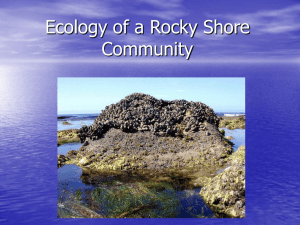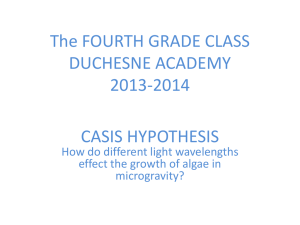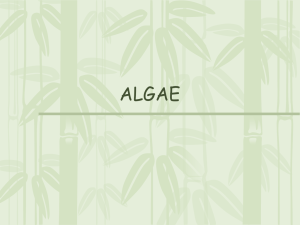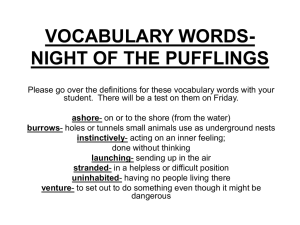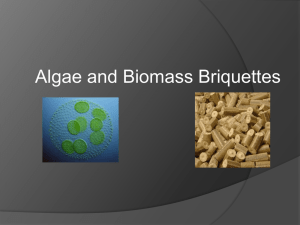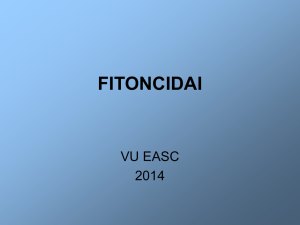5. Rocky Shore
advertisement
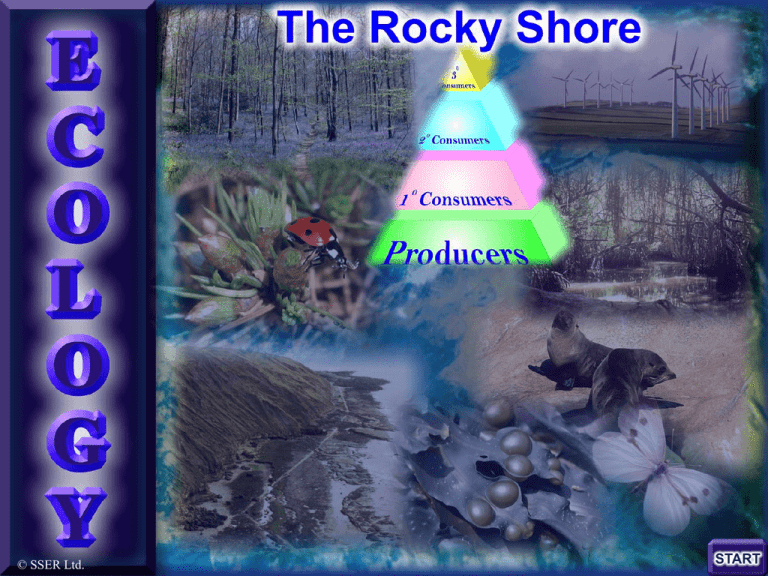
© SSER Ltd. The Rocky Shore Rocky shores are diverse and dynamic ecosystems where the inhabiting communities survive between two worlds – the sea and the land The familiar shoreline or littoral region is that area of shore which lies between the high-water mark and the low-water mark of spring tides These littoral zones may differ greatly from one another as local geology, wave action and aspect, influence the structure of the shoreline Living organisms in these intertidal regions face continual fluctuating environmental conditions as they are subjected to cyclic exposure and submergence from tidal activity The distribution of life on the littoral shore reflects the development of specialised structures and tissues that adapt the different species to the prevailing conditions Differences in exposure to the force of the waves have a modifying effect on the communities inhabiting sheltered and exposed shores Diversity on The Rocky Shore The sheltered rocky shore provides a variety of habitable environments where the diversity and the composition of species can be related to their positions on the shore The exposed rock faces, cervices and intertidal pools provide habitats for a range of species that display adaptations to the local prevailing conditions The sheltered rocky shore described here is located on the east coast of North Yorkshire where encrusting barnacles and mussels and seaweeds dominate the shore The following discussion describes the findings of a group of students who surveyed the shore and who carried out a number of investigations based upon their observations The Lower Shore Environmental conditions on the lower shore are less harsh and relatively stable as surface populations are never uncovered by the tide for more than a few hours at a time Species diversity is high on the lower shore and competition for food and space is fierce Fucus serratus (toothed-wrack) is the dominant brown alga of the lower shore and is intolerant of desiccation (cell wall thickness 0.45 mm) Red algae are intolerant of desiccation and form dense turfs beneath the carpet of Fucus serratus; these algae are tolerant of shade and possess the additional pigment (phycoerythrin) for efficient photosynthesis at low light levels Sponges, anemones, sea slugs, blenny fish and shrimps occupy this zone alongside many other species of animals and algae The Laminaria Zone The Laminaria Zone is occupied by species that are rarely uncovered by the tide but are subjected to intense wave action Environmental conditions in this zone are relatively constant and productivity is high; this is the least harsh area of the rocky shore providing niches for the establishment of a large diversity of organisms where competition is fierce The kelps (Laminaria species) are the dominant brown algae of this zone where they form underwater ‘forests’ displaying prolific growth These giant algae are intolerant of desiccation and possess flexible stipes that attach firmly to the ocean bottom with their powerful holdfasts Numerous, shade-tolerant species of red algae are found growing among the kelps Starfish, brittle stars, marine worms and sea urchins are found feeding in this zone Zonation and Diversity The zonation of both plants and animals observed on this sheltered shore reflected adaptations to different environmental conditions, with diversity increasing from the harsh upper shore to the less harsh lower shore The brown algae displayed a distinctive zonation pattern that related largely to their ability to resist desiccation and to photosynthesise effectively Brown algae have developed specialised structures and tissues for reducing desiccation, anchoring themselves to the rocks and ocean bottom, and photosynthesising effectively Brown algae are distinguished by the presence of the accessory pigment, fucoxanthin; this brown pigment enables the algae to absorb blue-green light (the wavelengths that penetrate deep into the water) The holdfast at the base of the stipes of these brown algae anchors them to the rocks Organisms inhabiting the upper shore are subjected to fluctuating environmental conditions and the drying effects of the air during the tidal cycle Zonation pattern of brown seaweeds on the sheltered rocky shore A group of students investigated the distribution of brown algae along a sloping sheltered rocky shore A transect was laid down along the shore by laying a tape, at right angles to the sea, from the splash zone to the low water mark (LWM) A one metre, square quadrat frame was used to determine the percentage cover of algae at twometre intervals along the tape A five-point abundance scale was used to record the percentage cover of algae within each frame Abundance scale % Cover 1 < 5% 2 5 – 25% 3 >25 – 50% 4 >50 – 75% 5 75% Transect Results Species of Brown Algae Splash zone Upper Shore Middle shore Lower shore Pelvetia canaliculata Fucus spiralis Fucus vesiculosus Fucus serratus Laminaria sp. 2 5 1 2 2 2 3 5 3 2 1 4 1 2 1 2 4 2 1 4 3 0 1 3 5 18 HWM 16 14 Distance from low water mark (m) LWM 12 10 8 6 4 4 • Draw kite diagrams to illustrate the distribution of algae along the shore • Discuss the pattern of distribution displayed by the different species of algae • Suggest reasons for the pattern of distribution observed Kite Diagram for rocky shore transect Pelvetia canaliculata 16 Upper shore 14 12 10 Middle shore 8 6 4 Lower shore 2 0 Fucus Fucus spiralis vesiculosus Fucus serratus Laminaria sp. Brown Algae and Desiccation Students collected samples of three different species of brown algae in containers of seawater and returned them to the laboratory for further investigation Each group of students collected three samples of Fucus serratus, Fucus spiralis and Fucus vesiculosus After blotting off the excess seawater, all the samples were weighed and their initial masses recorded Clamp stands and string were used to construct ‘washing lines’ to which the algae were then attached The algae were weighed every thirty minutes for the first two hours and then hourly for a further three hours The percentage fresh mass at each time interval was calculated for each species and the group results were pooled The mean percentage fresh mass was determined and the results presented graphically Pooled Results Time (mins) Mean Percentage Fresh Mass Fucus spiralis Fucus vesiculosus Fucus serratus 0 100 100 100 30 93.14 87.33 81.32 60 84.79 78.08 73.62 90 77.77 73.13 66.61 120 72.69 61.73 54.97 180 62.47 54.36 47.36 240 56.32 48.75 42.36 300 51.44 44.22 38.57 Construct a graph of the data obtained Mean % Change in Mass against Time for different species of brown algae Relate these results to the zonation pattern of the algae

